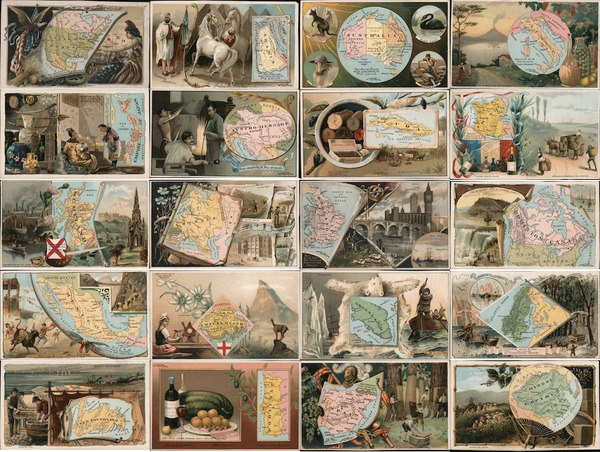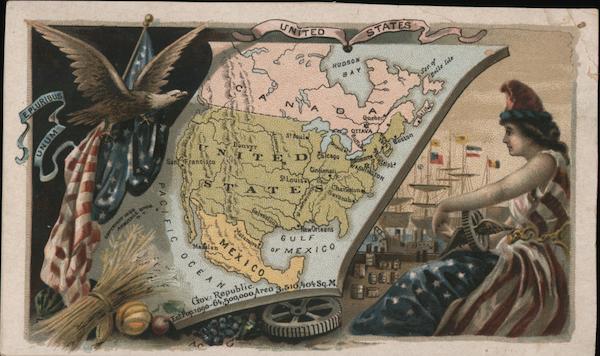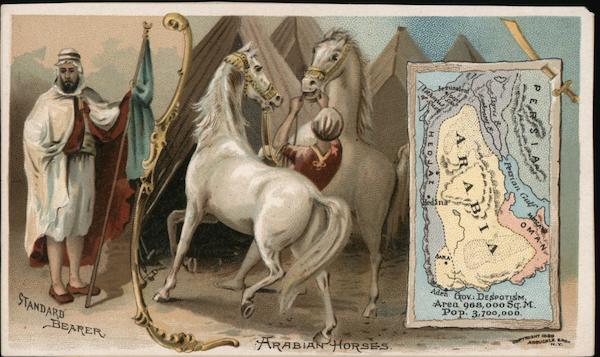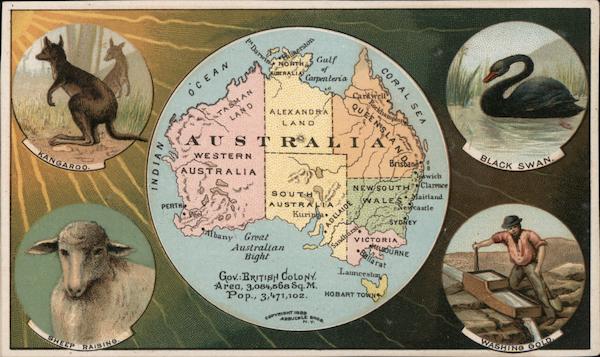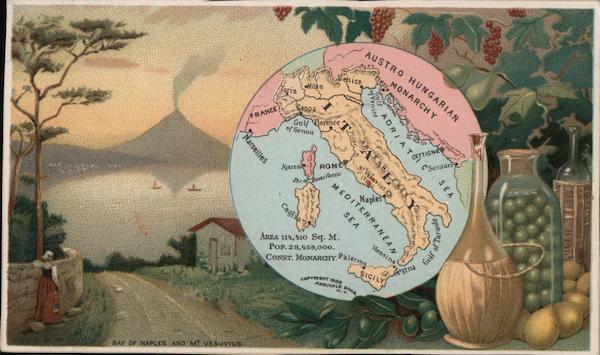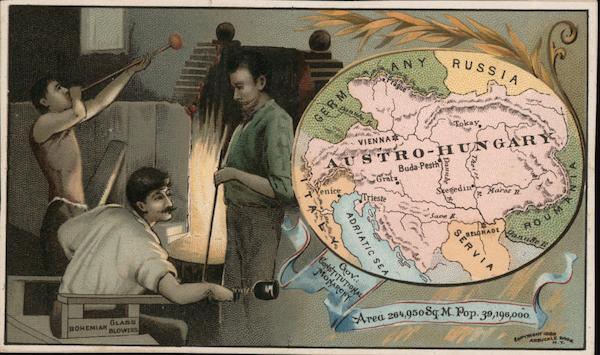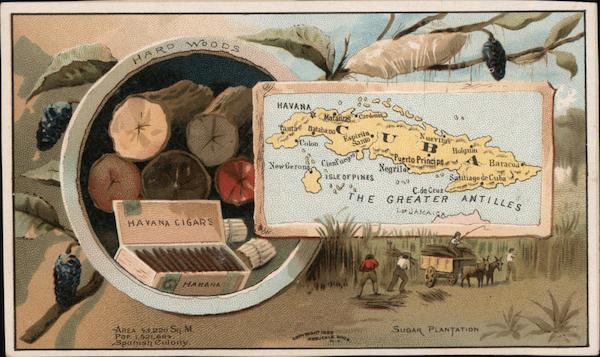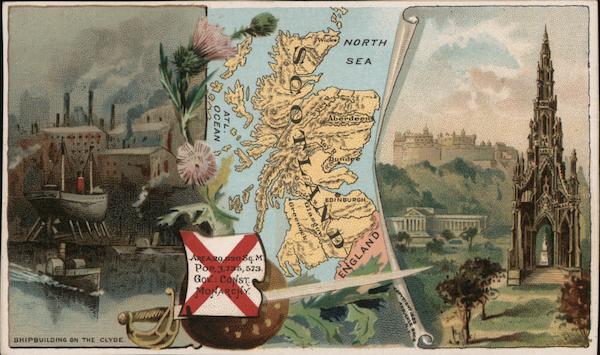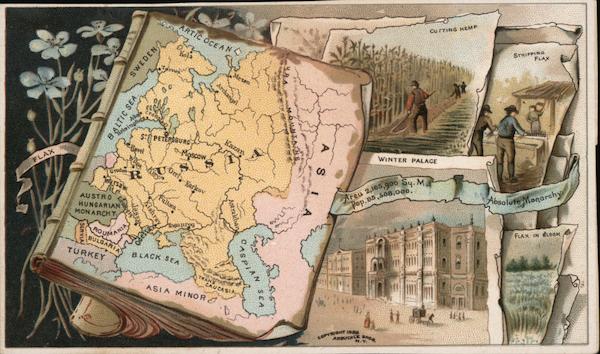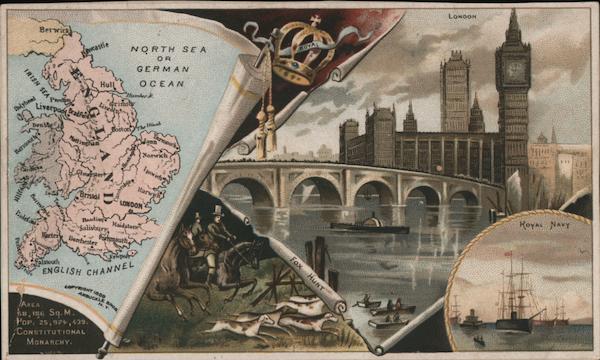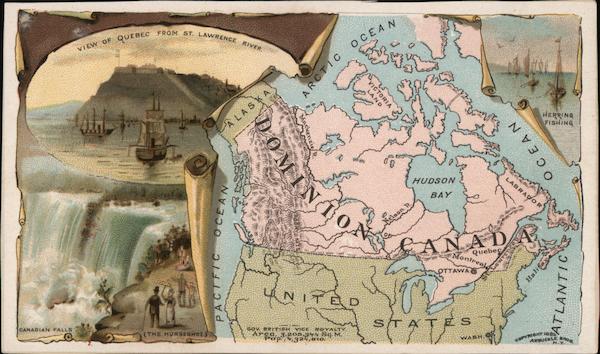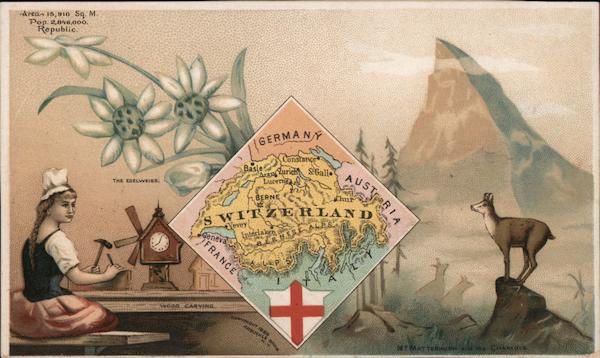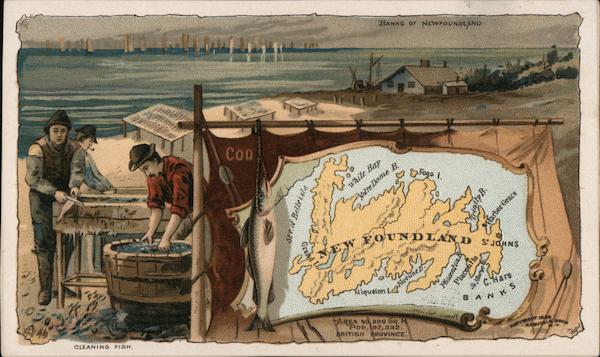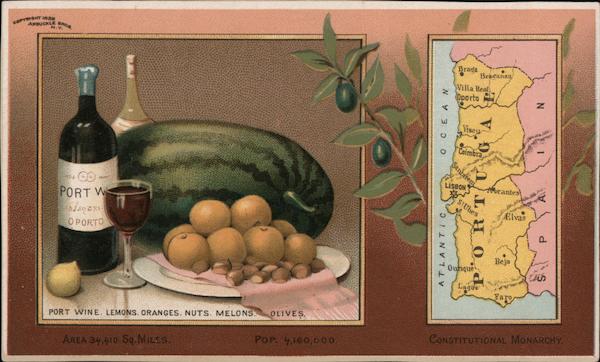Lot of 20: Arbuckle Coffee Trade Cards, Various Countries
Front:
Ser. of
Belle Isle
HUDSON
E PLURIBUS
Quebec
St oule
QTTAVA
Donver
Detpoit
Boston
I T E D' chicago
Batimores
elph=
Cinfinnati
ASHINGTON
S Louisa
AT
Chatleton
Savanah
COPYRIGHT I889
ARBUCKLE BRO
Galveston
N.Y.
Matamora
NewOrleans
6 ULF
Mazalan
OF MEXIC O
Gov: Republic.
Est Pop1890-64,500,000,Area 3,510,404Sq.M
Buffa
fissouri
PACIEIC
UNUM
setusaleni
Deed
Tothmhus
af Suet
Medina
BANA
Aden Gov.: DESPOTISM.
Area`968,000 Sq. M.
Pop. 3,700,000.
COFYRIGHT IB89
ARBUCKLE BRO
N.Y.
STANDARD
ARABIAN HORSES.
BEARER
Euptrates
Perrian Gulf
OM AN
ww.aMu
A RAB, I A
Imerston
Gulf
NORTH
AUSTRALI
of
Carpenteria
OCEAN
TASMAN
LAND
Cardwell
Rockham
QUEEN'S LA N
ALEXANDRA
LAND
U ST
RAL I A
KANGARO.
Brisbanes
BLACK SWAN
AUSTRALIA
Ipewich
Clarence
NEW SOUTH
PERTH
Peel
SOUTH
AUSTRAFIA
Kuringa•
WALES Maitland
*Newcastle
SYDNEY
Fal bany Great
VICTORIA
Australian
Bight
MELBOURNE
Ballarat
Sandhúrst
Launceston
Gov.:BRITISH COLONY.
Area, 3,084,568 Sq.M.
Pop., 3,471,102.
HOBART TOWN
COPYRIGHT I889
ARBUCKLE BROS
N.Y.
SHEEP RAISING.
WASHING GOLD.
CORAL SEA
P Darwin
D.
INDIAN
AUSTRO HUNGARIAN
Milan
Turin
Xenice
MONARCHY
Geno a
Gulf Florence
of Genoa
ERANCE
CETTIGNE
Scutari
M! Vesuvius
ROME
Ajaccio
(Valc)
Str.o Bonifacio
Naples
Caglia
AREA 114, 410 Sq. M.
POP. 28,459,000.
CONST. MONARCHY. Palermo
Messina
MEtna
SICILY
COPYRIOHT 1889
ARBUCKLE BROS
N.Y.
BAY OF NAPLES AND MỊ VESUVIUS.
Trieste
SEA
Culf
SofVenice
ADRIAT
Tiber
of Taranlo
MEDITERRANEAN
SEA
Marseilles
COPYRIGHT I889
ARBUCHLE BRO
N.Y.
AREA 146,5L Sa M.
Por 38 623 379.
Gov. MONARCHY
SEA
OF
JAPAN M
Yokohama
Kioto
Osaka
JAPANESE NOBLE
COREA
EMPIRE
OF JAPAN
OCEAN
PACIFIC
RUSSIA
ANY
Prague
MEokay
mura
VIENNA
nd Buda-Pesth
Gratz
USTRO-H UN GARY
Skegedin
Maros R.
Wenice
Trieste
Sape K.
Panude
BELGRADE
Gov:
CONSTITUTIONAL
MONARCHY
Area 264,950 SqM. Pop. 39,196,000.
COMONT IB89
ARBUCKLE BRO
N.Y.
GLASS
BLOWERS
BOHEMIAN
Danube
SERVIA
GERM
ADRIATIC SEA
WOODS
HARD
HAVANA
Matanzas Cardenas
Taută Batabano
Espirita
Santo
Colon
Nuevitas
Holguin
Puerto Principe t
Negrilo
New Gerona
Cienfuegs
Baracoa
1SLE OF PINES
Saltiago de Cuba
C.de Cruz<
THE GREATER ANTILLES
1.OF JAMAIC
HAVA NA CIGARS
HABANA
AREA 43,220 Sq. M.
POp 1,521. 68%.
Spanish Colony
COPYRIGHT1889
ARBUCKLE RO
SuGAR PLANTATION
N.Y.
ENGLISH CHANNEL
Lille
Havre
Caen
Brest
Akranches Versailles
Rouen
Reims
Odeans
Nancy
Basle
BERNE
SWITZER-
LAND
Nantes
Bap
Nevers
of
Limoges
Biscap
Bordeaux
Lyons
ATALY
Nimes
Toulouse
Republic
Pop. 37,672,000.
Area 204,080 Sq.M.
Marseillese
Toulon
MEDITERRANEA N
alier
SEA
R.F.
DON
COPYRIOHT !889
ARBUCKLE BROS
N.Y.
GÁTHERING GRAPES IN THE VINEYARD.
WINES. SPIRITS. SILKS.
BELGIUM
tenoa
ATLANTIC OCEAN
Wicke NORTH
SEA
Spey
Aberdeen
Dundee
etyde
EDINBURGH
Eitimio
AREA 29 820 8q. M
POp, 3,735,573.
Gov.: CONST
MONARCHY
SHIPBUILDING ON THE CLYDE.
COPYRIGHT 1889
ARBUCKLE BRO
Glasgow
ENGLAND
Greenock
ATL.
OCEAN
Cu ITING HEMP
STRIPPING
FLAX
ARTIC OCEAN{}
Kola
rnea
Mezen
Abol
Cronsiadi
Kazan
WINTER PALACE
Helsingfots
$TPETERSBURG
reßerel
Areu 2,165,900 Sy. M.
Pop.85,508,000.
Wilna ieve
Moosowa
Absolute Monarchy
Orel Karkov
FLAX
Grodno
Warsaw
Pultova
FLAX IN BLOOM
AUSTRO
HUNGARIAN
MON ARCH Y
Inganrog
ANIA
ROUN
BULGARIA
TURKEY
BLACK SEA
TRANS
CAUCASIA
ASIA MINOR A
it.
COPYRIGHT IB80
BROS
N.Y.
ARBUCKLE
Archangel
Astrakhan
SWEDEN
CASPIAN
SEA
BALTIC SEA.
Kishrsy
Jasyy
ember
SERVIA
LONDON
Berwick
ROYAL
NORTH SE A
OR
wcastle
GERMAN
OCEAN
Hull
Humber K.
folyhead
Prest
Liverpoo Brad
erimsty
Lincolu
Denbie
Bostonhe Wash
Yarmouth
Mattingham
Lynn
Norwich
Barmouth
Ipswich
lougrstert
Harwich
Bristal
RoyAL NAVY
LONDON
Reading
Maidstone
Salisbury,y
Partsmouth
Hxcter Derchester
Leunce
Fox HUNT
yoduen
Falunouth
Srure
ENGLISH CHANNEL
COPYRIONT IB89
ARBUCKLE BROS.
AREA
$8, 186 Sq. M.
Pop. 25,97,439.
CONSTITUTIONAL
MONARCHY.
IRISH SEA
nbridge
Barnstaple
pnce
VIEW OF QUEBEC FROM ST. LAVWRENCE RIVER.
ARCTIC OCEA
ALASKA
HERRING
FISHING
HUDSON
LABRADOR
BAY
R.
Nels
ANADA
Quebec
Montreal
OTTAWA
YNIT
CANADIAN FALLS
(THE HORSESHOE)
GOV. BRITISH VICE ROYALTY
Area, 3,205,344 Sq. M.
Pop.,4,324,810.
WASH, O
COPYRIGHT 1889
ARBUCKLE BRO
N.Y.
VICTORIA
LAND
Ma
DOMINT
OCEA N
ROOKY MT
OCEAN
Hacu enry
Halifa
PACTFIC
AT LANTIC
SPomas
• Tubae
Rio Grande
Santa Ana
Hermosillo
Guaymas
Sinaloa
Brownsville
Bagdad
Santa Rosa
Loreto
Matamoras
Linares
MULE TRAIN
CROSSING THE MOUNTAINS.
San Luis
Culiacan
La Paz
COPYRIGHT I889
ARBUCKLE BROS
N.Y.
SilanS
Victoria
Tampico
Cosala
PACIFIC
Merida.
Campeche Valladolid
Lerma
Bacalare
B.Grande
Taxpan
Vera Craz
АГvaredo
Minatitlan
San Blas
Autlan
Quadalaxara
Eiudad Real
AcutlaTehuantepec.
CENTRAL AMERICA
GUATEMALA
OCEA N
Quesaltenang
Pop.10,000,00o. Area 772,00o Sq.M.
Gov.:Federal Republic.
BULL FIGHTINE
GULF
of
Calipornia
Gulf
Low CALIFORN
Areas 15,91o Sq. M.
Pop. 2,846,00.
Republic.
Lurich SGalle AUSRTA
Constance
Basle
Arap
Lucerne
Chur
3.
BERNE
THE EDELVWEISS.
S WIT ZE RLAND
Yevey
Interlaken e
Geneva
HERNESE
FRANCE
WOOD CAR VING
COPYHIGHT I889
ARBUCKLE BRO
AMOIS
MTMATTERHORN and
PENGUINS
GREENL
JAN MAHEN I.
ICELAND
Humbola
Glavters
Upernavik
DAN
AMERICA
ARCTIC
CIRCLE
BAFFIN
BAY
"Herrnhuy
Davis Strait
DISCO .
CUMBER
Area
76,740 Sq. Mil.
LAND
COPYRIGHT 188s
ARBUCKLE BFOS
C.Farewell
N.Y.
Danish Colony
op.9.780
WALRUS
HUNTING
fnizh saund
ATLANTIC OCEAN
EXPORTING
GRAIN.
ARCTICOCEAN
LAPLAND
Irnen
FISHERIES.
Dronthein
LUMBERING.
Fahlm
Gefle
Bergu
Opsal
OCHRISTIANN FA
G.of Finland
STOCKHOLM
St.Petersburg
Göteburg Gothland
halnar
8.
Aret
299,610 Sq. Miles.
Pop. 6,497, 000.
Constitutional Monarchy.
COPYRIGHT 1889
ARBUCKLE BRO
N.Y.
LTLANTIC OCEAL
Bothnia
Gulf of
BankS OF NEWFOUNDLAND
CD
White Bap
o Fogo I.
Natm Dame R
OUNDLAND sJaHNS
Miquelon LA
Fortune
C. Hare
BAN K S
CLEANING FISH,
AREA 40 200 Sq. M.
Pop, 197,332.
BRITISH PROVINCE
MONT IB88
ARBUGKLE BRO
Y.
SEr.of Belleisle
Grand
YninttpB.
Harbor Grace
Plaentia
COPYRIGHT 1889
ARBUCKLE BROS
N.Y.
Braga
Braganza
Villa Real
Oporto
Viseu
Caimbra
LISBON
orantes!
SUbes
PORT W
Elvas
P.
OPORTO
Beja
Ourique
Lagds
Faro
OLIVES,
PORT WINE. LEMONS, ORANGES. NUTS. MELONS.
CONSTITUTIONAL MONARCHY.
POP 4,160,000
AREA 34,410 Sq. MILES.
O CEAN
Santatem
ATLAN TIC
Gov., MONARCHY.
POP, 16,835,506.
Area,196,081 Sq. M.
Ferrol
SCorunna
Bilbao Andora
Leon
Barcelona
Saragossa
Segovia
"Tortosa
MADRID
Valepcia
P.
Talavera
Murcja
Den Benito
Bada fog
Cartagena
Almeria
Palos
Malaga
Cadiz
Giblaltar
Str of Gibraltar ME
1angier
ARBUCKLE BRO
COPYMONT IB89
Cenfa
GATHERING CORK.
MALAGA GRAPES
UGAL
Alicante
TERRANE AN SEA
TEA
AREA, 4,455,000 Sq. M.
PLANT
POP, 380,000,00
RICE PLANT
ER
Klachka
B.
Maimatchin
CHINE SE
Kanchow
rümtsi
Káshgar
PEKING
Tien-tsin
Nanking
Markandmu
MPI RE
Hoang
Leh
CHIN
Amoy
Canton
Hopgkong
FooChow
Yangtser Kiang
PACIF IC
PICKING TEA LEAVES.
Gov., APSOLUTE & DESPOTIC MONARCHY.
R.
BEA
wOCEAN
COPYRIGHT 1889
ARBUCKLE B4
BROS
Back:
FRANCE.
TZRANCE, one of the largest and most important countries of Europe, is
I bounded N. by the English Channel and the Strait of Dover; w. by the
2° Bay of Biscay; S. by the Pyrenees and the Mediterranean Sea.
Since September 4, 1870, France has been under a Republican form of gov-
ernment. The legislative power is vested in the Chamber of Deputies and the
Senate, and the executive in the President (elected for seven years) and the
Ministry.
The surface of France is on the whole a somewhat monotonous plain, inclin-
ing gently downwards fron, the Alps and the Pyrenees in a north-westerly direc-
tion to the Atlantic. The climate is remarkably fine.
Area 204,080 square miles; population 37,672,000. The country is essentially
agricultural, the South rich in vines and fruits, the North in wheat and other
cereals. The French have long been esteemed the first of wine-makers. France
has many industries, the principal being the production of silks and velvets.
Paris, the capital (and by far the most beautiful of the large cities of Europe,
singularly rich in public buildings, and especially palaces), is noted for the
variety and extent of its manufactures, including machinery, chemicals, porce-
lain, mirrors, clocks, watches, gloves, hosiery, modes, and above all in jewelry.
Sèvres has great manufactures of porcelain and glass ware ; Rheims, of merinoes;
Gobelins, of tapestry and cashmeres.
France has productive coast fisheries. The Normandy breed of horses is
famous.
The colonial possessions and protectorates of France (including Algeria), dis-
persed over Asia, Africa, America and Polynesia, embrace a total area of 2,814,000
e ihn nanulation of 20 20 202
RUSSIA,
T USSIA, the largest empire in the world, and, after China and the British
at Empire, the most populous, comprises one-seventh of the land surface of
w the globe.
The government is an absolute hereditary monarchy. The whole legislative,
executive and judicial power is united in the Emperor whose will alone is law.
European Russia is represented on accompanying map.
Area, 2,165,900 square miles, one-third of which is under forest. Population,
85,508,000.
The northern half of E. R. is a land of forest and morass, with rivers and
lakes; the southern half, an immense expanse of rich, arable land. An area of
230,000 square miles, has a deep loamy soil of inexhaustible fertility, producing,
without manure, the richest crops.
The climate is singularly healthy, though the extremes of temperature are
greater than in any other country of Europe or Asia. In the N. the White sea
is ice-bound from July till winter.
The cereal crops are wheat, rye, barley, oats, potatoes. Immense quantities
of hemp and flax are grown all over the country. Of the wild animals a large
proportion are fur-bearing, and the export of furs is large. The soil is rich in
ores of all kinds and mining industry is steadily increasing. Coal, anthracite,
raw naphtha, benzine, and heavy oils, are increasingly important products. One
of the specialties of Russia is its unrivalled leather (Russia and Morocco) for
book-binding. The fisheries are a very considerable source of revenue St.
Petersburg, the capital, contains a larger number of palaces than any other city
in the world, the most magnificent being the Winter Palace, the lavishingly
ARGENTINA REPUBLIC.
T HE Constitution of the Argentine Republic, a group of States formerly
V known by the name of the Confederation of the Rio de la Plata, bears
date May 15, 1853, with modifications in 1860, when Buenos Ayres joined
the confederacy. The executive power is left to a President, elected for a year;
while the legislative authority is vested in a National Congress, consisting of a
Serate and House of Deputies. The Republic includes fourteen provinces and
nine territories, and according to a last estimate the area is 1,095,000 square
miles, and the population 2,540,000. The increase in population has been due
greatly to immigration. Nearly 1,000,000 immigrants arrived in the six years,
ending 1889, most of whom were from the south of Europe, the Italians forming
seventy per cent. of the total. There is little doubt that the population since
last estimate has increased to over 4,000,000.
Agriculture is little prosecuted, but millions of cattle and large droves of
horses and mules are raised on the rich pasturage of the Pampas. Mining has
not been vigorously engaged in. The exports consist of tallow and stearine,
mutton, skins (mainly sheep), hides, wool and grain. Buenos Ayres is the
principal city, zud he outlet of all the trade of the Republic.
CUBA.
CUBA, “the Pearl of the Antilles," and the one colony of importance be-
1 longing to Spain, is the largest and wealthiest island of the West Indies,
and is about 150 miles distant from the two great peninsulas of Florida
and Yucatan. It was discovered by Columbus 28th October, 1492, and was
occupied by the Spanish in 1511.
The area is 43,220 square miles, ten per cent. of which is cultivated, seven
per cent. is unreclaimed, and four per cent. is under forests. There are large tracts
of country still unexplored. Cuba is divided into three provinces, the south-
east and central being the richest and most populous. Above Trinidad, on the
S. coast, the rugged mountain masses are not without grandeur, while the rare
beauty of the coast and inland scenery is unsurpassed by that of the most re-
nowned of the Mediterranean lands. The western department contains almost
all the great sugar factories and tobacco plantations.
The population in 1877 was 1,521,684, of whom 977,992 were Spaniards,
10,632 foreign whites, 43,811 Chinese, and 489,249 negroes. In 1886 slavery was
absolutely abolished.
The capital, Havana, the principal city in the West Indies, is the key to
the Mexican Gulf, and has one of the finest harbors in the world. It is unsur-
passed by any city in the world for its beautiful public parks, shady drives and
promenades, and numerous fountains.
The principal productions are sugar, tobacco, coffee, rice and cotton. The
sugar cultivation is the most profitable. Large quantities of honey, rum, wax,
tobacco, cigars and hard-wood are exported from Havana.
THE NETHERLANDS.
V HE KINGDOM OF THE NETHERLANDS (low lands) or Holland,
U lies to the north of Belgium and to the east of the North Sea. In
V many parts the surface is below the level of the adjacent canal, or
river, and even of the sea. A great part of the coast is defended by sand
hills, which the natives protect by sowing them with binding grasses, and in
other places enormous dykes have been built.
By the Constitution the Netherlands forms a Constitutional and hereditary
monarchy. The executive power belongs exclusively to the Sovereign, while
the whole legislative authority rests conjointly in the Sovereign and Parlia-
ment, the latter, called the States-General, consisting of two chambers.
The area of the Netherlands is 12,740 square miles, and estimated popula-
tion 4,114,000. The Colonial possession, situated in the East and West Indies,
embrace an area of 766,137 square miles, with a total population of 29,550,000.
Holland is chiefly a grazing country. The cheese of Gouda, Leyden &
Edam is famous. There are valuable fisheries along the coast and, in various
parts of the North Sea. The diamond-cutting trade of Amsterdam is the largest
in the world. Among the chief manufactures are the linens known as “Hol-
lands," the gin which goes by the same name, Delft pottery and Utrecht car-
pets. Chief among the exports are butter, cheese, live animals (principally
cows and sheep). Other leading exports (mainly the produce of the Dutch
colonies) are coffee, mostly exported to the United States, sugar, raw cotton,
tobacco, spices and dried fruits. THE HAGUE, the capital, is a handsome,
fashionable, healthy city, intersected by numerous canals.
INDIA is the geographical term applied to the central peninsula of Southern
Asia, which is bounded on its landward base by the Himalaya Mountains
On and the rivers Indus and Brahmaputra.
Here, the word India will be understood in its modern political signification,
as comprehending the entire region over which Queen Victoria exercises
supremacy as Empress of India ; excluding Ceylon and the Straits settlements of
Singapore, &c., the administration of which is in the hands of governors, under
control of the Secretary of State for the Colonies, and not of the Indian Govern-
ment.
The executive authority is vested in a Governor-General (appointed by the
Crown, and acting under order of the Secretary of State for India), and as-
sisted by a Council of not less than to members.
The total area is 1,425,700 square miles. The population 255,000,000.
The physical aspect is extremely varied, and represents the grandeur of
tropical phenomena on a most impressive scale. The Himalaya Mountains ex-
hibit both the loftiest peaks and the highest level of elevation in the world.
The delta formed by the confluence of the Ganges and the Brahmaputra, is
perhaps the most fertile spot in the world.
The climate is thoroughly tropical, except in the most favored hill stations.
The chief industry has always been agriculture. Rice, millets, barley, wheat,
grain and maize form the staple food-grains. Fruit trees, vegetables and spices
abound. The commerce and trade is very large and annually increasing. Ex-
ports include raw cotton, yarn, opium, wheat, rice, jute, tea, coffee and indigo.
Calcutta, the city of palaces, is the residence of the Governor-General, and
the greatest Eastern commercial centre.
TURKEY.
11. URKEY, or Ottoman Empire, one of the largest and most populous States
V of the Old World, consisting of adjacent parts of southeastern Europe,
PV Western Asia and Northern Africa.
The fundamental laws of the Empire are based on the Koran, and the will
of the Sultan is absolute, in so far as not in opposition to the accepted truths of
the Mahometan religion. The legislative and executive authority is exércised
under the supreme direction of the Sultan, by two high dignitaries, the Grand
Vizier and the “Sheik-ul-Islam.” The whole of the empire is divided into
governments, subdivided into provinces and districts.
European Turkey is represented on accompanying map. Area, 63,800 square
miles. Population, 4,490,000. It is for the most part mountainous, but with
richly varied scenery ; its fertility is boundless, and its climate, as a whole, is
genial and healthy. Only a small proportion of arable land is under cultivation,
and the system of agriculture is most primitive. The Turkish peasant is in-
dustrious, ignorant and submissive. The principal products are tobacco, cereals
of all kinds, cotton, figs, nuts, almonds, grapes, olives, and all variety of fruits.
Coffee, madder, opium and gums are largely exported. Other exports are
wools, silks, carpets, morocco leather, meerschaum, attar of roses, drugs and
dyestuffs. The want of roads and means of conveyance are great obstacles to
cultivation and trade.
Constantinople, the capital, and metropolis of the empire, is the residence of
the Turkish Sultan, whose seraglio or palace, is of vast extent. Of its 344
mosques, the most interesting in Constantinople is that which was formerly the
Church of St. Sophia.
GREECE.
GXREECE, or the modern KINGDOM OF THE HELLENES, is the southern por-
V tion of the most eastern of the three European peninsulas that project into
of the Mediterranean Sea, and was declared a kingdom in 1830, after having
thrown off the yoke of Turkey. It is distinguished among European countries,
as Europe is among continents, for the great extent of its coast line, 2700 miles.
It has every diversity of climate, from the winter severity of Arcadia to the
sultry heat of the marshy plains.
The executive is vested in the King and his responsible ministers (the heads
of seven departments), and the whole legislative power in a single chamber of
representatives, called the Boulé, elected by manhood suffrage, for the term of
four years.
Area, 24,970 square miles. Population, 1,979,000, the great majority of whom
are adherents of the Greek Orthodox Church.
The capital is Athens, where on the Acropolis stands the ruins of the Par-
thenon, whose harmony and grand proportions make it still one of the wonders
of the world.
Greece is mainly a pastoral and agricultural country, the land being to a
large extent in the hands of peasant proprietors, but on the whole, agriculture
is in a backward state. The manufactures are few and unimportant. The
currant (Ital. papolina) or small Corinthian grape, is the most favored and best
cultivated crop, and among other fruits are the vine, olive, almond, orange,
lemon and fig. The staple article of export is currants, other articles are olive
oil, lead, silver ore, zinc, sponges, dye and tanning stuffs.
JAPAN.
TAPAN (Niphon, "land of the rising sun”) is an insular empire in the E.
@ of Asia, comprising the four large islands of Niphon (the Japanese main-
Te land), Sikok, Kiusiu and Yesso, and as many as 3,500 smaller ones, includ-
ing the Kurile Islands.
The system of government of the Japanese Empire was that of an absolute
monarchy. A Constitution was, however, promulgated on February II, 1889.
By it the Emperor is the head of the Empire, combining in himself the rights
of sovereignty and exercising the whole of the executive powers, with the
advice and assistance of the Cabinet Ministers. There is also a Privy Council.
The Emperor exercises the legislative power, with the consent of the Imperial
Diet, consisting of two Houses.
Area, 146,544 square miles; population, 33,623,379.
The climate varies greatly, but in the central part is generally mild and
agreeable. The land is cultivated chiefly by peasant proprietors, tenancy being
rare. The Japanese are good agriculturists and pay great attention to irrigation,
manures and the rotation of crops, and their soil, a fertile friable loam, is chiefly
under tea and rice, but other products are cotton, tobacco, wheat, maize,
potatoes and vegetables. Fruits are abundant. The mineral wealth is great,
and the waters abound in fish, which, in addition to rice, forms the staple food
of the people.
The Japanese are singularly skillful in the manufacture of silks and cottons,
and are unsurpassed for the exquisite beauty of their porcelain, lacquer work
and bronzes. The Japanese are an agreeable, sprightly, polished people;
ingenious, clean and frugal
GUIANA.
XUIANA, the name of an extensive tract of country in the N. E. of S.
America, extending along the coast of the Atlantic and distributed between
of Great Britain, The Netherlands and France.
The united area, 178,000 square miles. Population, 347,000, the aboriginal
Indians not being included.
BRITISH GUIANA includes the settlements of Demarara, Essequibo and
Berbice, named from the three great rivers. T. Governor is assisted by a Court
of Policy (9 members, 5 elected), and a Combined Court, containing, in addition
to these 9, 6 Financial Representatives. The Colon is making steady progress
under British governinent. Dutch Guiara is called by the Dutch Surinam,
from its principal rlver, and is under a Governor General and Council of native
freeholders. Gold is found, and is one of the exports.
FRENCH GUIANA is under a Governor. It is poorly cultivated and its trade
insignificant. Gold digging is almost the only industry.
The climate of Guiana is hot and moist, the mean temperature being 81° F.
The climatic changes are sudden and are generally accompanied by violent
hurricanes and thunderstorms. Guiana is only cultivated along the coast flats
and for a short distance up several of the rivers, and the field laborers now
mainly come from China, the West Indies and India.
The principal products are sugar, timber, cacao, rum, molasses, gums,
balsams, drugs, cloves, pepper, rice and maize, bananas, pineapples, coffee and
rice. Chief of its gorgeous flowers is the Victoria regia, one of the largest of
water lilies.There is a great variety of excellent fish, and birds of splendid
R plumage abound, including the parrots humming birds and famingoes
CENTRAL AMERICA,
CENTRAL AMERICA forms the connecting link between the two greater
KOD divisions of the continent, and comprises the Republics of Guatemala,
Honduras, Salvador, Nicaragua and Costa Rica, and the British Colony
of Balize or British Honduras.
Area, 179,742 square miles. Population, 2,417,300.
The executive government of the republics is vested in Governors, and the
legislative in National Assemblies, Councils, or Congress of Deputies.
GUATEMALA has an exceedingly fertile soil, and minerals exist, but are little
worked. Sixty per cent. of population are pure Indians.
HONDURAS has forests or mahogany and other cabinet woods, and is rich in
gold, silver, copper and coal, which are, however, little wrought.
NICARAGUA has left her magnificent resources almost wholly undeveloped,
and the chief occupation is the rearing of cattle, carried on in a rude fashion.
SALVADOR is the smallest, but most densely populated, and, next to Costa
Rica, most advanced of the Republics of Central America. San Salvador, the
capital, has been repeatedly destroyed by earthquakes.
* In COSTA RICA almost anything can be grown, but in 1889 the principal
agricultural products were coffee and bananas.
BALIZE is noted for its production of mahogany and logwood. The transit
trade greatly increases the traffic of her ports.
The principal exports from Central America are coffee and indigo; others
are hides, skins, cocoanuts, bananas, pineapples, sugar, gums and drugs,
Peruvian balsam,” mahogany and other woods.
PERU.
J ERU.The Republic of Peru, formerly the most important of the Spanish
21 Viceroyalties in South America, declared its independence July 28th, 1821.
5 The present Constitution, revised November, 1860, is modelled on that of
the United States, the legislative power being vested in a Senate and House of
Representatives, and the executive being entrusted to a President, elected for
four years, who exercises his functions through a Cabinet of five ministers.
The area is 425,000 square miles, and the population (including about 350,000
uncivilized Indians) 3,050,000. Lima, the metropolis, is one of the gayest and
grossest capitals in the world.
The scenery of Peru is probably unique for imposing grandeur and variety,
a distinction due to the singular contour of its surface. Within its limits are to
be found a number of the loftiest mountain peaks, the most stupendous preci-
pices and ravines, the most arid and desolate plateaux, and the most fruitful
tropical valleys to be met with in the world.
Peru is pre-eminent over all South American countries for the frequency and
violence of its earthquakes.
The staple productions of Peru are cotton, coffee, cocoa, rice, sugar, tobacco,
wines and spirits and maize. Besides these there are in the country India
rubber, cinchona, dyes, medicinal plants and balms and the wool of the alpaca
and the vicuña. The guano deposits are to a great extent exhausted, the quan-
tity exported to Great Britain being only 6,064 tons in 1889 as against 156,864
tons in 1876, and the nitrate province of Tarapaca now belongs to Chili. Gold
mining is now inconsiderable, but silver, copper and tin are still worked.
VENEZUELA.
T HE Republic of VENEZUELA was formed in 1830 by secession from the
We other members of the free State founded by Simon Bolivar within the
to limits of the Spanish colony of New Granada. Venezuela was discovered
by Columbus in 1498, and in 1499 Vespucci and Ojida seeing in Lake Maracaybo,
the Indian village of Cora, which was built upon piles, called it Venezuela or
Little Venice, an appellation subsequently extended to the whole country.
The charter of fundamental laws is designed on the model of the Constitu-
tion of the United States of America, but with considerably more independence
secured to provincial and local governments.
Venezuela is divided into eight large States, each subdivided into sections or
districts, besides the Federal District, two national settlements and eight terri-
tories.
Area, 439,000 square miles: Population according to the census of 1881,
2,075, 245, one-fifth of which was engaged in agriculture.
The surface of Venezuela is naturally divided into three distinct zones : the
agricultural, the pastoral, and the forest zone. In the first are grown sugar-
cane; coffee, which is the chief export; cocoa, cereals, etc.; the second affords
runs for cattle, horses and mules, which are now reared in great numbers and
are largely exported; and in the third, tropical products, such as caoutchouc,
tonca beans, copaiba, vanilla, sarsaparilla, growing wild, are worked by the
inhabitants.
Venezuela is rich in metals and other minerals, while sulphur, coal, asphalt,
lead, koolin and tin are also found.
Caracas, the capital has a mild climate but is liable to earthauakes Some.
PORTUGAL.
FOORTUGAL, the most westerly Euro,nan kingdom, is physic-11, one witin
2Spain, occupying the Atlantic margin of the Iberian penins , and has an
G average breadth of only 100 miles with a length from N. to S. of 370 miles.
The crown is hereditary in the female as well as the male line; but with
preference of the male in case of equal birth-right. The Constitution recognizes
four powers in the State--the Legislative, the Executive, the Judicial and the
"Moderating' authority, the last of which is vested in the Sovereign. There
are two legislative chambers-the House of Peers and the House of Commons.
The Azores and Madeira are regarded as an integral part of the Continental
Kingdom.
Area, 34,410 square miles. Population, 4,160,000.
Portugal has Colonial possessions in Africa and Asia, with a total area of
592,066 square miles and a population of 3,988,951.
Lisbon is the capital, and one of the most beautiful harbors in the world.
It has suffered much from earthquakes, that of ist November, 1755 destroying
the greater part of the city and some 50,000 lives.
The surface of Portugal is in great part mountainous, the scenery combining
highland grandeur of form with the bright subtle colors of a Southern clime.
There is a great diversity of climate, but the dry, oppressive heats of Central
Spain are unknown. The mineral wealth is considerable, but there is little
mining enterprise. There are no manufactures of importance. Wine is the
most important product, especially the rich, red, port wine, so called from being
shipped at Oporto. The chief exports are wine, oil, cork, oranges, lemons, nuts,
melons, olives, pyrites and wool.
MOROCCO.
OROCCO (Arab, Maghrib-el-Aksa, "the extreme west) is a Sultanate
VL in the N. W. corner of Africa, forming part of the seaboard of the
O Mediterranean and Atlantic. The form of government is in reality an
absolute despotism, unrestricted by any laws, civil or religious. The Sultan is
chief of the State, as well as head of the religion, and he and his subjects are of
the Malekite sect of Mohammedans. The differences are chiefly in the attitudes
assumed during the recitals of prayers.
Area, 219,000 square miles; population, 2,750,000.
The mountains nowhere reach the level of perpetual snow, but the higher
peaks of the Atlas are white as late as April, while the lower slopes are clad
with luxuriant forests of valuable timber trees. In the great western plain the
climate is remarkably temperate and equal. The districts along the margin of
the Sahara are swept by scorching winds.
Agriculture is carried on in a very primitive way. Among the products are
wheat, maize, rice, sugar, cotton, tobacco, peas and beans, saffron, grapes,
oranges, almonds, figs and dates. The live stock consists of large herds of
cattle, horses of a small but spirited breed, and the goats whose skin furnish the
famous morocco leather. The manufactures include morocco leather, carpets,
shawls, flint-lock guns, beautifully inlaid with gold and silver ; leather dyes,
colored tiles and elegant water jars.
Morocco, one of the capitals, is girt by a wall 23 feet high and 772 miles in
circuit, and contains some 20 mosques and several large bazaars. The palace of
the Sultan, outside the walls, is a magnificent building.
C ENTRAL AFRICA contains several semi-barbarous independent Str's,
KOD the Sultans of which are, in principle, absolute monarchs. *"lese States
are, the CENTRAL SOUDAN STATES, Bornu and Wadai; RUANDA, in the
equatorial lake region, and LUNDA, to the east of the Portugese African
Colonies. Under this head may also be included the old Egyptian Soudan.
Bornu is the most populous Mohammedan State in Central Soudan, and
occupies the western and southern sides of Lake Tsad. Wadai is at present the
most powerful State in Central Soudan, and has several vassal States. The
Arabs have been settled in the country for over 500 years. Their traders send
caravans south and west bartering salt and manufactured goods for ivory,
slaves, ostrich feathers and copper; but the political power is in the hands of
the Mohammedan Mabas, a negro people.
DAHOMEY has in recent years been greatly reduced in size and strength,
and will probably soon be annexed to France. The natives are of pure negro
stock, and fetish worshippers, and are industrious agriculturists.
The LUNDA EMPIRE is still the largest and most populous in the whole of
the Congo basin. Its ruler is suzerain of about 300 vassal chiefs and kinglets,
who pay tribute in kind-ivory, lion and leopard skins, corn and salt. The chief
exports are ivory and slaves.
The CONGO FREE STATE was placed under the sovereignty of the King of
the Belgians by the International Congo Conference, and declared neutral and
free to the trade of all nations.
The principal exports of CENTRAL AFRICA are palm oils, India rubber, gum
copal, ground nuts, ivory, coffee and cam-wood.
BELGIUM.
71. HE Kingdom of Belgium formed itself into an independent State in 1830,
V having previously been a part of the Netherlands, and, according to the
Constitution of 1831 is “a Constitutional, representative and hereditary
monarchy.” The legislative power is vested in the King, the Chamber of Re-
presentatives, and the Senate, the members of both Houses being chosen by the
people.
Belgium has an area of 11,370 square miles, and is the most densely populated
State of Europe. The population is 5,520,000. On the whole a flat country, it
is along the coast little raised above the high water level, and has to be pro-
tected against the inroads of the sea by artificial dykes, where the natural bar-
riers, consisting of sand hills, are either awanting or inadequate.
The climate is chilly and humid, there being on an average some 150 rainy
days in the year. The soil consists of either sand or clay, and is not naturally
fertile, but indomitable energy and skill have brought seven-eighths of the
whole surface under cultivation, and forced from it twice as much corn as is re-
quired by the vast population of the whole country.
Belgium abounds in coal fields and iron mines, and at Seraing near Liege, there
is one of the largest iron works of Europe. Among the manufactures for which
it is chiefly celebrated are Brussels carpets, fine lace and thread, and the rare
lawn and damask fabrics of Bruges. The ordinary domestic animals of Europe
are reared everywhere in perfection, and to Flanders belongs a famous breed of
large horses, of which great numbers are exported to foreign countries.
SANDWICH ISLANDS.
TV, HE SANDWICH or HAWAIIAN ISLANDS, a group situated in the N. Pacific,
U 2100 miles from San Francisco and 3400 miles from Japan. They num-
ve ber twelve, of which eight are inhabited, the remainder being little more
than large rocks. The whole group is of volcanic orig. The island of Hawaii
contains two immense volcanoes, Mauna Loa (13,760 feet) and Kilauea (3970
feet), whose craters are respectively 6 and 9 miles in circumference, and are
constantly active. The climate is mild and equable, and the soil highly fertile
and productive. The bread-fruit, cocoa nut, banana and tara are indigenous,
and every tropical crop can be successfrily reared. Sheep, cattle and horses
thrive well and are now very numerous. Sugar and rice are the staple indus-
tries, while coffee, hides, bananas and wool are also exported.
The Sandwich Islands were practically discovered on 19th January, 1778, by
Captain Cook, who was killed by the natives of Hawaii on the following year.
He named them the Sandwich Islands after the Earl of Sandwich, First Lord of
the Admiralty. Owing to missionary labors, the islands are now wholly
Christian.
The government is a Constitutional Monarchy. In 1887 a new constitution
was granted, by which the executive power is vested in the Sovereign and his
Cabinet.
The total area of the islands is 6677 square miles, and the population, ac-
cording to census of 1884, 80,578, of whom 40,014 were natives and 17,939
Chinese. The native population, which is closely allied to the Maoris of New
Zealand, is rapidly decreasing and the foreign population increasing.
ITALY.
ITALY is the mid-most of the three great peninsulas in the south of Europe,
9 and in outline is strikingly like a long, high-heeled boot.
On The Government is a limited monarchy-the executive power belonging
exclusively to the Sovereign, and is exercised by him through responsible min-
isters; while the legislative authority rests conjointly in the King and Parliament,
the latter consisting of two Chambers, the Senate and the Chamber of Deputies.
The area is 114,410 square miles, the population 28,459,000. The capital is
Rome. The climate is singularly fine, in spite of the winter severity in the
North and almost tropical heat in the South. Of the total area, 86.9 per cent.
is productive, but agriculture is generally in a primitive condition. The chief
crops are wheat, maize, rye, barley, oats and rice. The vine flourishes every-
where. The fruits exported are oranges, citrons, lemons, dates and melons.
The other chief exports are silk, olive oil, wine, hemp, sulphur, chemical pro-
ducts, almonds, marble and other stones, and iron ore.
Italy has possessions in Africa, and exercises a protectorate over Abyssinia
and other territories.
The most notable feature in the geology of Italy is its volcanic system.
Vesuvius (the only active volcano in Europe and the most famous in history)
rises a solitary peak from the Campanian plain, which stretches along the N. E.
shore of the lovely Bay of Naples.
According to Italian statistics, 151,609 Italians emigrated to the U. S. and
Canada during the six years 1884 to 1889.
AUSTRALIA.
COTT,USTRALIA, an island, or, as it is now considered by many, a continent;
M bounded on the N. by the Arafura Sea and Torres Strait, on the E. by
or the Pacific Ocean, on the S. by Bass Strait and the Indian Ocean, and
on the W. by the Indian Ocear. Its area is equal to about three-fourths that of
Europe.
The Australian colonies comprise New South Wales, Queensland, South
Australia, Victoria, Western Australia, (all on the main continent), New Zea-
land, situated 1,200 miles to the E. of the continent, and Tasmania, formerly
called Van Diemen's Land, an island lying to the S. of Australia, and having
fifty-five smaller islands adjoining it included in its area.
Total area of these Colonies, 3,084,568 square miles. Population, 3,471,102.
The executive is in the hands of Governors appointed by the Imperial Gov-
ernment, the legislative in local Parliaments consisting of two Houses
The climate of such a territory as Australia, stretching over 29 degrees of
latitude, is necessarily very diversified. One-third of its ciimate is tropical. Of
the remaining two-thirds the climate varies, and in the most southerly portion
is very similar to that of the S. of France.
Gold is found in several of the colonies and everywhere in N. S. Wales.
Immense numbers of sheep are reared, and wool is the staple export. Other
exports are gold, copper, tin, wheat, flour, hides and skins, live animals, frozen
and preserved meats, fruit and jams. The Kangaroo is found only in Australia,
and first-rate leather is made from the hides of the larger species. The black
swan (Cygnus Atratus) is also peculiar to Australia.


